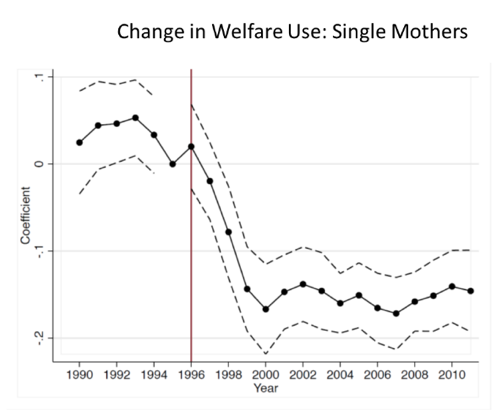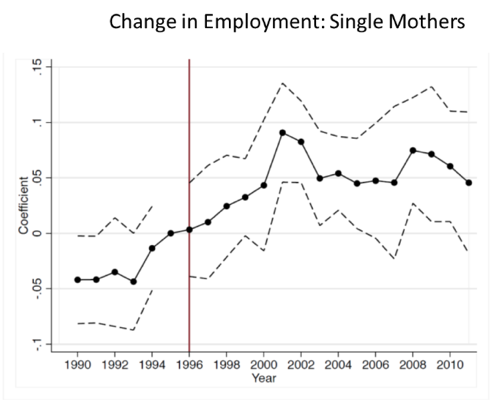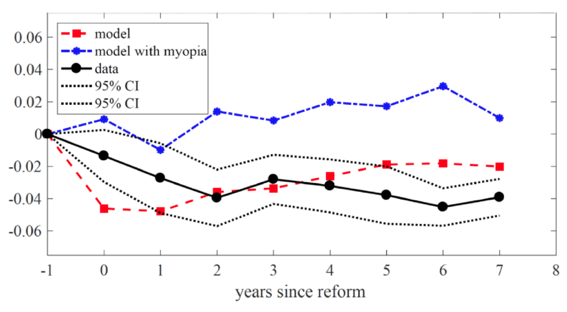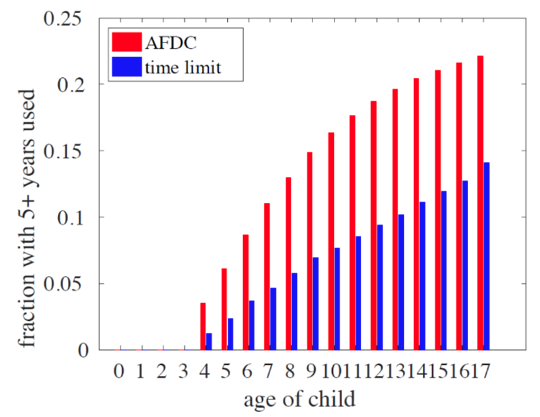In 1996, Clinton’s administration radically reformed welfare provision in the US. Aid to Families with Dependent Children (AFDC) was replaced by Temporary Aid to Needy Families (TANF). The key change was the introduction of time limits on the receipt of welfare, with the aim to make welfare support only a temporary recourse rather than a permanent provision of insurance. At the time of the reform, 32% of low-educated single mothers were in receipt of AFDC – there was pressure to reduce claimants, to increase employment, and to reduce the number of single mothers. By 2008, the percentage of single mothers claiming TANF had fallen to 8%. The key questions this raises are:
- What has happened to those who would otherwise have been on benefits?
- Why did behaviour change?
- Who has gained and who has lost because of the reform?
The strictness of time limits varied by state, with some imposing five-year limits, others just two years, and some others initially having no limits at all. Additionally, time limits were introduced alongside other changes to the welfare system – the imposition of work requirements for those claiming benefits, and the devolution of decision making over the allocation of the welfare budget and welfare rules to the states. Part of the challenge in understanding the effect of time limits is in disentangling the effect of time limits from other reforms.
Grogger and Michalopoulos (2003) use data from an experiment in Florida and conclude that the imposition of time limits caused an anticipatory decline in welfare utilisation (saving the benefits for the future) of about 16%. Chan (2013) subsequently also finds sizable reductions in welfare use and increases in labour supply by single mothers.
To consider the longer-term effects of time limits and the overall welfare consequences, we look at impacts over the entire lifecycle and on various outcomes, including effects on divorce and marriage. Time limits on welfare effectively reduce the financial support for single mothers and increase their exposure to risk. This has the effect of increasing the incentives for them to work, so as to accumulate savings and avoid running down benefit entitlement, which might be particularly important sometime in the future. But it also increases the incentive to remain married, so as to better share labour market risk with a partner. In a recent paper, we consider these joint decisions in an integrated framework, analysing empirically how the change in incentive structure associated with the time limits reform is reflected in observed behaviour (Low et al. 2018).
We first provide direct evidence of the effect of time limits on welfare use, employment, marriage, and divorce by comparing changes over time in the behaviour of women that are more likely to be exposed to time limits relative to other women. Figure 1 shows that welfare use declined dramatically and persistently, especially for single women, and that employment increased. Importantly, much of the increase was not just a mechanical effect of people being removed from welfare rolls because they hit the time limit. We provide evidence that people ‘saved’ their entitlement, in anticipation of worse times ahead. However, the increase in employment was only half of the fall in welfare use, meaning a rise in the number of women neither on welfare nor employed.
Figure 1 Change in welfare use and employment
In addition, Figure 2 shows that rates of divorce declined with the introduction of time limits, as the difficulty of being single increased. On the other hand, marriage rates and fertility did not change. In other words, once married, individuals were less likely to split up. In itself this is likely to reduce single motherhood substantially.
Figure 2 Change in divorce
It is clear that the new programme has reduced the amount of insurance available; it is, however, an open question whether it increased social welfare, by reducing the tax burden of funding the programme, or reduced social welfare by providing less insurance. To investigate these issues we need to turn to a model.
Explaining the changes and evaluating their effect on wellbeing
To uncover the underlying mechanisms, we estimate a life-cycle model of family formation, welfare program participation, labour supply, and saving. In the model marriage happens for a number of reasons – mutual love plays a key role of course, but being married also offers economic benefits, including saving on commonly consumed goods (such as heating, housing expenses, etc.), bringing up children together, and sharing labour market risk. However, these economic circumstances can change, affecting the economic benefits of marriage. For example, if policy makes it more attractive to remain single, this will be a force pushing towards divorce. On the other hand, if policy makes single life harder, all else being equal, divorce will be less likely. In our case, the imposition of time limits exposes single people to increased risk from adverse labour market outcomes, leading to less divorce.
Our approach is to use pre-reform data to estimate the model and to validate it by checking that it produces the immediate, short-run effect of the reform. The model reproduces the reduced form results accurately – welfare use declined as women deferred claiming benefits until their children were older. Half of this decline was offset by a rise in employment, and some women chose not to claim at all after the reform. On the other hand, a large fraction of those not claiming welfare do not work either. For this group of women, who have to rely on food stamps or their partners, there has been a worsening of the outside option to marriage, a decline in welfare of women who remain married, and a decrease in divorce – these women who were already the worst off before reform are now even worse off.
The estimates show clear evidence of forward-looking behaviour – women change the timing of when they claim welfare because of potential future needs.
In Figure 3, we compare our forward-looking model with what welfare use would have looked like if individuals had been myopic and not realised the time limit was going to be imposed. The model with forward-looking behaviour and banking of benefits captures what we estimate directly from the data.
Figure 3 Myopia and forward-looking behaviour
The delay of claiming benefits is shown explicitly in Figure 4, which reports the simulated fraction of low-educated women who reach five years of benefit use by the age of their child, before and after the introduction of time limits. The level of welfare use falls and the timing is delayed.
Figure 4 Fraction reaching five years of benefit use
Implications
Ultimately, welfare policy has its trade-offs. By imposing time limits, it would have been possible to reduce taxes raised from this specific group of people. However, this population is willing to forgo this potential benefit and pay 0.5% of life cycle income to have access to the original pre-reform welfare system. And single mothers value the unrestricted benefits by about 2% of lifetime consumption. In other words, the insurance value lost as a result of the reform is not offset by the revenue raised, even when spent on this demographic (women with less than college education). This leads to a more general lesson – while it is true that welfare systems can be distorting of both work and family formation decisions, the insurance they offer against adverse effects is highly valued.
Finally, to conclude, we provide evidence that the reform led to a rise in employment and a fall in divorce, as was intended by the law. Further, the sharp rise in the number of single women without welfare or employment led to substantial welfare costs and left US families with young children with only a very limited safety net when the Great Recession started.
References
Chan, M (2013), “A dynamic model of welfare reform”, Econometrica 81(3): 941–1001.
Grogger, J and C Michalopoulos (2003), “Welfare dynamics under time limits”, Journal of Political Economy 111(3): 530–554.
Low, H, C Meghir, L Pistaferri and A Voena (2018), “Marriage, labor supply and the dynamics of the social safety net”, NBER Working paper 24356.













